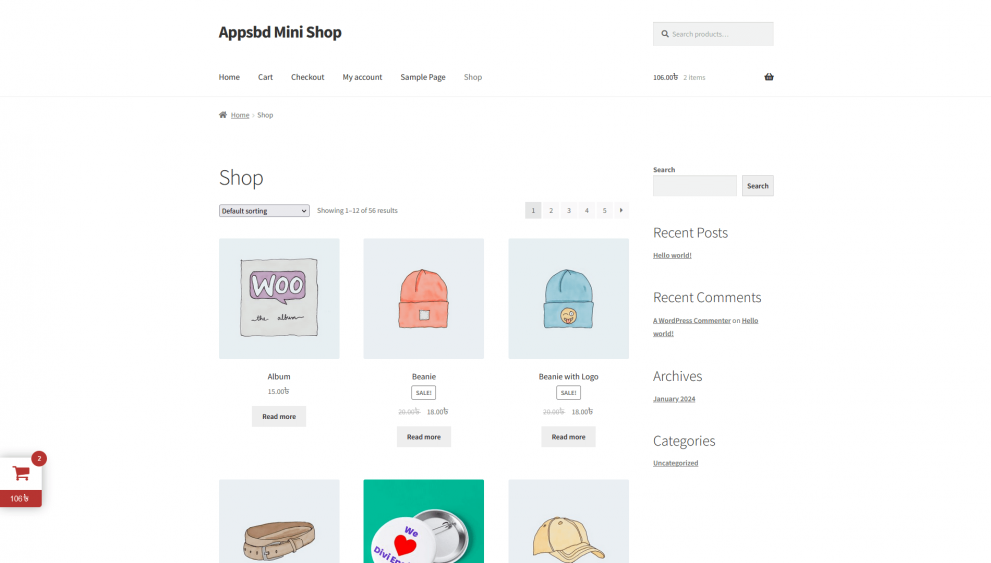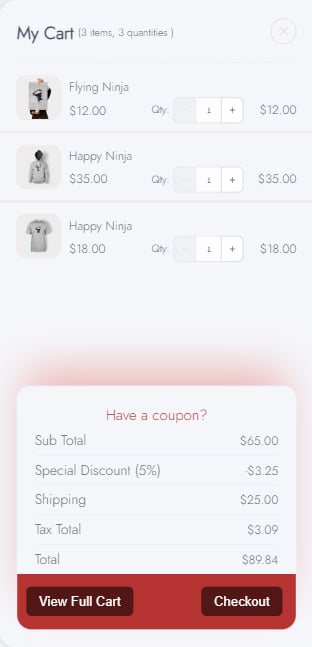
Transformative Impact: Boost User Engagement with a Dynamic Floating Cart
Written by Md Ferdous Hassan Alin. Posted in Mini Cart, WooCommerce, WordPress No Comments
Introduction
In the fast-paced world of e-commerce, user engagement is a critical factor in driving sales and ensuring customer satisfaction. One of the latest innovations designed to enhance user engagement is the floating cart. This article delves into the impact of shopping cart on user engagement, exploring their benefits, implementation challenges, and future trends.
What is a Floating Cart?
A floating cart is a modern, dynamic shopping cart that remains visible and accessible as users navigate through an e-commerce site. Unlike traditional shopping carts, which are typically static and require users to navigate away from their current page to view their items, shopping carts hover on the screen, allowing users to add and view items without interruption.
Benefits of a Floating Cart
Enhanced User Experience
- Shopping cart provide a seamless and intuitive shopping experience. Users can easily add items to their cart and view them without leaving the current page, reducing friction and enhancing satisfaction.
Increased Conversion Rates
- By keeping the shopping cart visible at all times, shopping cart remind users of their intended purchases, reducing cart abandonment and increasing the likelihood of completing a purchase.
Seamless Shopping Experience
- The persistent presence of a shopping cart ensures that users have constant access to their selected items, making the shopping process smoother and more efficient.

How Floating Carts Improve User Engagement
Accessibility and Convenience
- Float carts make it easy for users to review their selections and make adjustments without navigating away from their current page. This accessibility reduces frustration and keeps users engaged.
Reduced Friction in the Purchase Process
- By minimizing the steps required to view and manage the shopping cart, float carts streamline the purchase process, making it quicker and more enjoyable for users.
Persistent Cart Visibility
- The constant visibility of the cart serves as a gentle reminder of pending purchases, encouraging users to complete their transactions.

Design Elements of an Effective Floating Cart
User-Friendly Interface
- A well-designed float carts should be intuitive and easy to use, with clear buttons and a simple layout.
Customization Options
- Offering customization options allows businesses to tailor the float carts to their brand and user preferences, enhancing the overall experience.
Responsive Design
- An effective float carts should be responsive, adapting seamlessly to different screen sizes and devices to ensure a consistent user experience.

Case Studies: Success Stories of shopping cart
Example 1: Major Retailer
- A leading retailer implemented a float cart and saw a 20% increase in conversion rates, attributing the success to the enhanced user experience.
Example 2: Niche E-Commerce Store
- A niche e-commerce store reported a significant decrease in cart abandonment after introducing a float cart, highlighting the importance of persistent cart visibility.
Example 3: Global Marketplace
- A global marketplace integrated a float cart and experienced improved customer satisfaction and higher sales volumes.
Common Challenges and Solutions
Technical Implementation
- Integrating a float cart can be technically challenging. So Appsbd makes a Mini Cart drawer for WooCommerce. Just install the plugin and enjoy its feature. So no need to create a new cart or no need any developer. Mini cart drawer have Free and Pro version. If you use pro then you will get more advance options.
User Adaptation
- Some users may initially be unfamiliar with floating carts. Clear instructions and an intuitive design can help ease the transition. Appsbd provide video tutorials to get full instaractions.
Balancing Aesthetics and Functionality
- Striking the right balance between a visually appealing design and functional usability is crucial. Regular testing and user feedback can help achieve this balance.
The Role of Floating Carts in Mobile Commerce
Mobile Optimization
- With the increasing use of mobile devices for online shopping, ensuring that float carts are optimized for mobile platforms is essential.
User Behavior on Mobile Devices
- Understanding user behavior on mobile devices can help in designing floating carts that cater to the specific needs of mobile shoppers.
Future Trends in E-Commerce and Floating Carts
AI and Machine Learning Integration
- The integration of AI and machine learning can enhance the functionality of float carts, providing personalized recommendations and improving user experience.
Personalization Features
- Future float carts are likely to incorporate advanced personalization features, tailoring the shopping experience to individual user preferences.
Voice Commerce Compatibility
- As voice commerce becomes more prevalent, float carts may evolve to include voice command functionalities, further enhancing user convenience.
Measuring the Impact of a Floating Cart
Key Metrics to Track
- Important metrics to track include conversion rates, cart abandonment rates, and user engagement levels.
Tools for Analysis
- Utilizing tools such as Google Analytics and heat mapping software can provide valuable insights into the effectiveness of float carts.
Best Practices for Implementing a Floating Cart
A/B Testing
- Conducting A/B testing can help determine the most effective design and functionality for float carts.
User Feedback and Iteration
- Gathering user feedback and continuously iterating on the design can lead to improvements and a better overall user experience.
Ensuring Security and Privacy
- Ensuring that float carts comply with security and privacy standards is crucial in maintaining user trust and satisfaction.
User Feedback and Continuous Improvement
Gathering and Analyzing Feedback
- Regularly collecting user feedback can provide insights into areas for improvement and help enhance the float cart experience.
Iterative Design Process
- Adopting an iterative design process allows for continuous improvements based on user feedback and evolving needs.
Sugetons to Use more plugin if you have a E-Commerce shop.
- Vitepos: Use your online store as local store with Vitepos.
- Elite Notification: Best WordPress Marketing Plugin to Display Sales PopUp & Skyrocket Conversion Rates and more.
Conclusion
In conclusion, floating carts have a significant impact on user engagement in e-commerce. By providing a seamless, intuitive, and persistent shopping experience, they enhance user satisfaction, reduce cart abandonment, and increase conversion rates. As e-commerce continues to evolve, float carts will likely play an increasingly important role in shaping the future of online shopping.
FAQs
How does a Floating Cart enhance user engagement?
- This shopping cart improve user engagement by providing constant visibility, reducing friction in the purchase process, and offering a seamless shopping experience.
Can a Float Cart be used on mobile devices?
- Yes,
- This shopping cart can be optimized for mobile devices, ensuring a consistent and accessible shopping experience across different platforms.
What are the challenges of implementing a Float Cart?
- Challenges include technical implementation, user adaptation, and balancing aesthetics with functionality. These can be mitigated with experienced developers and regular user feedback.
How can I measure the effectiveness of a Float Cart?
- Effectiveness can be measured using metrics such as conversion rates, cart abandonment rates, and user engagement levels, along with tools like Google Analytics and heat mapping software.
